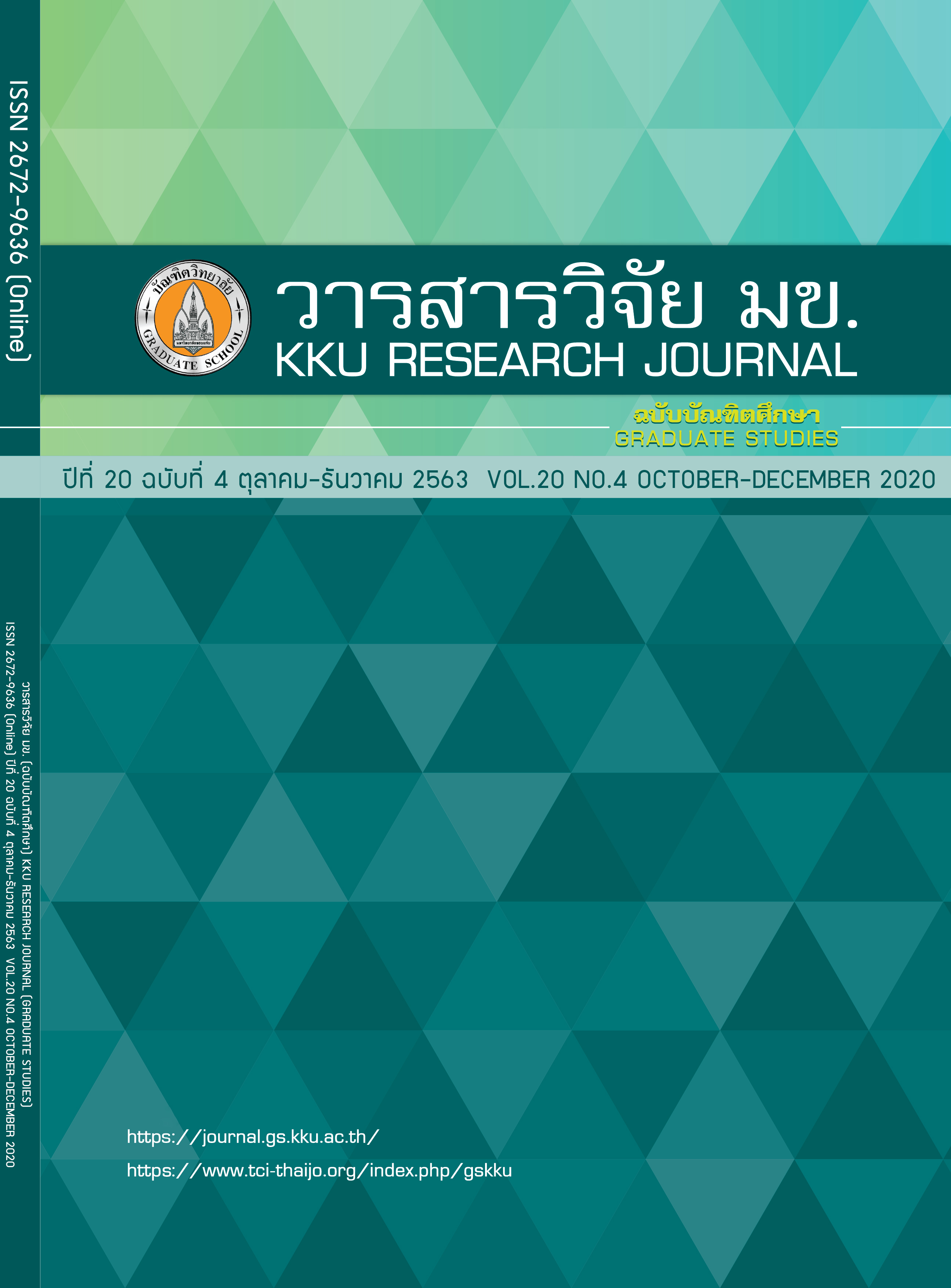Factors Effect on the Effective Field Capacity of Thai Combines Harvesters when Harvesting: A Case Study of the Phitsanulok-2 Rice Variety
Keywords:
Grain harvesters, Field performance, Off-season rice variety, Combine harvestersAbstract
This study aimed to find the effect of the factors on the field capacity of Thai combine harvesters. 27 of Thai combine harvesters which harvesting the Phitsanulok-2 rice variety were randomly collected. The results showed that factors affected on the field capacity were total area harvested, travelling speed, the experience of operators, and weed density. Also, the percentage of these factors was 41.18 28.94 12.47 and 11.06 %, respectively. Finally, the total area harvested should be over than 6.25 rai and travelling speed should be 3.00 - 6.50 km/hr because of easy turning at the headland, decreasing lost time, and increasing effective field capacity.
References
Office of Agricultural Economics [Internet] 2019 [cited 2019 Oct 1]. Available from http://www.oae.go.th/view/1/Information/EN-US
Mongkol-Tanatas J. 36 years of Agricultural Machineries. Bangkok: Ministry of Agriculture and Cooperatives; 2009.
Chuan-Udom S. Grain Harvesting Machines. Khon Kaen: Khon Kaen University Press.; 2013.
Nantajit C. Difference between Investment in Rice Combine Harvester Service from Central and North East of Thailand. Khon Kaen Agr. J. 2016; 59-65.
Department of Internal Trade (DIT) [Internet] 2018 [cited 2018 Nov 2]. Available from https://www.dit.go.th/Gallery.aspx.
Chinsuwan W, Mongpraneet S, Panya N. Oprimun Harvest Period for Hommali Rice using Combine Harvester. KKU Research J. 1997; 2(1): 54-63.
Potikamorn A, Chinsuwan W. Effect of Harvesting Period on Losses of Quantity and Quality for Chainat 1Rice Variety when Harvested with Combine Harvester. KKU Res J (GS). 2016; 16(4): 57-63.
Junsiri C, Chinsuwan W. Prediction Equations for Header Losses of Combine Harvesters when Harvesting Thai Hom Mali Rice. Songklanakarin Journal of Science and Technology. 2009; 31(6): 613-620.
Chuan-Udom S, Chinsuwan W. Threshing Unit Losses Prediction for Thai Axial Flow Rice Combine Harvester. Agricultural Mechanization in Asia Africa and Latin America. 2009; 40(1): 50-54.
Sangwijit P, Chinsuwan W. Prediction Equations for Losses from Thai Axial Flow Rice Combine Harvesters. Thai Journal of Agricultural Science. 2011; 44(1): 23-31.
Liang Z, Li Y, Xu L, Zhao Z, Tang Z. Optimum Design of an Array Structure for the Grain Loss Sensor to Upgrade Its Resolution for Harvesting Rice in a Combine Harvester. Biosystems Engineering. 2017; 157: 24-34.
Siska J, Hurburgh CR. Prediction of Wisconsin Tester Breakage Susceptibility of Corn from Bulk Density and NIRS Measurements of Composition. Transactions of the ASAE. 1994; 37(5): 1577-1582.
Maertens K, De Baerdemaeker J, Ramon H, De Keyser R. An Analytical Grain Flow Model for a Combine Harvester, Part I: Design of the Model. J. agric. Engng Res. 2001; 79(1): 55-63.
Maertens K, De Baerdemaeker J. Flow Rate Based Prediction of Threshing Process in Combine Harvesters. Applied Engineering in Agriculture. 2003; 19(4): 383-388.
Miu PI, Kutzbach HD. Mathematical Model of Material Kinematics in an Axial Threshing Unit. Computers and Electronics in Agriculture. 2007; 58: 93-99.
Udompetaikul V. Development of A Computer Program For Management of Rice Combine Harvesting Under Custom Operation System [M.Eng.]. Khon Kaen: Khon Kaen University; 1999. Thai.
Meyer E. Some Measurement of Mechanical Sugarcane Harvesters Performance. Proc. S. Afr. Sug. Techno. Ass. 1998; 73.
Amiama C, Bueno J, Álvarez CJ. Influence of the Physical Parameters of Fields and of Crop Yield on the Effective Field Capacity of a Self-Propelled Forage Harvester. Biosystems Engineering. 2008; 100(2): 198-205.
Doungpueng K, Chuan-Udom S. Effects of Guide Vane Inclination Patterns on Threshing Losses and Power Requirement. Kasetsart Journal (Natural Science). 2014; 48(1): 313–322.
Khir R, Atungulu G, Chao D, Pan Z. Influences of Harvester and Weather Conditions on Field Loss and Milling Quality of Rough Rice. Int J Agric & Biol Eng. 2017; 10(4): 216-223.
Špokas L, Adamčuk V, Bulgakov V, Nozdrovický L. The Experimental Research of Combine Harvesters. Res. Agr. Eng., 2016; 62(3): 106-112.
Elsoragaby S, Yahya A, Mahadi MR, Nawi NM, Mairghany M. Comparative Field Performances between Conventional Combine and Mid-Size Combine in Wetland Rice Cultivation. Heliyon. 2019; 5(4).
Shreen FAM, Badawy ME, Abo El-Naga MHM. Comparison between the Most Common Mechanical Methods and Rice Combine Modified for Harvesting Wheat Crop in the Egyptian Fields. Egypt. J. Agric. Res. 2014; 92(2): 675-692.
Amponsah SK, Addo A, Dzisi KA, Moreira J, Ndindeng SA. Performance Evaluation and Field Characterization of the Sifang Mini Rice Combine Harvester. Appl. Eng. Agric. 2017; 33(4): 479-489.
Department of Primary Industries and Regional Development's Agriculture and Food (DPIRD) [Internet] 2019 [cited 2019 Sep 9]. Available from https://www.agric.wa.gov.au/pests-weeds-diseases/weeds.
Grains Research and Development Cooperation (GRDC). Soybean Section 12 (Harvest). Barton: Australia; 2016.
Bawatharani R, Jayatissa DN, Dharmasena DAN, Bandara MHMA. Field Performance of a Conventional Combine Harvester in Harvesting Bg- 300 Paddy Variety in Batticaloa, Srilanka. International Journal of Engineering Research. 2015; 4(1): 33-35.
Ebrahimi-Nik MA, Khademolhosseini N, Abbaspour-Fard MH, Mahdinia A, Alami-Saied K. Optimum Utilisation of Low-Capacity Combine Harvesters in High-Yielding Wheat Farms Using Multi-Criteria Decision Making. Biosystems Engineering. 2009; 103(3): 382-388.
Chegini GR. Determine of Optimum Operating Conditions of Combine Harvester with Stripper-Header. World Applied Sciences Journal. 2013; 23(10): 1399-1407.
ASAE Standards. ASAE D497.4 Agricultural Machinery Management Data. MI: USA; 2009.
Doungpueng K, Chuan-Udom S,Numsong A, Chansrakoo W. Lost Times of Harvesting Processes of the Thai Combine Harvesters. IOP Conf. Series: Earth and Environmental Science. 2019; 301.



